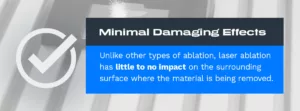Laser ablation allows for precise removal of surface materials without causing damage to the surrounding area. This highly effective process is used in various industries for laser marking, cleaning and texturing. Understanding the process of laser ablation and what makes it unique is key to determining when this method will work for a specific application.
Laser ablation is a method of removing materials on solid surfaces using high-energy laser beams. In some industrial sectors, CO2 and fiber lasers are preferred for this application due to the high efficiency, power and precision of these designs. Green and UV lasers are also utilized to create high-precision markings on material surfaces while operating at different wavelengths.
These lasers employ different settings and marking techniques when used for industrial laser ablation, resulting in a variety of outcomes. Every material has an ablation threshold, and these lasers are designed to reach that threshold in order to ablate and vaporize the surface.
When laser beams hit a surface, some energy is absorbed and converted into heat. If the intensity is above the ablation threshold, the materials are ablated. The materials that are removed from the surface are vaporized into fumes, creating laser markings on the workpiece.
Here are some advantages of laser ablation that make the process stand out from other techniques:
Laser ablation can be used to create markings on a wide range of materials, including glass, ceramics, metals and plastics.
With its narrow focal point, this process allows for detailed engraving or marking of various objects, making it a popular choice in the production industry. Some notable laser ablation uses in production and manufacturing include creating identifiers and unique logos on products.

Unlike other types of ablation, laser ablation has little to no impact on the surrounding surface where the material is being removed. Because this method allows for controlled and precise material removal in a localized area, it has a reduced chance of chipping, eroding or distorting the workpiece.
Laser ablation is more controllable when compared to other methods such as biological ablation, often referred to as chemical etching, and electro-ablation. These alternative processes can involve harmful chemicals and erratic application that lead to unpredictable outcomes. With industrial laser ablation, you can expect excellent results and long-term cost savings.
At Laser Marking Technologies, LLC, we develop high-quality laser ablation systems to help you optimize your processes for greater efficiency and cost-effectiveness. Our team has over 100 years of combined experience and the expertise to develop laser ablation systems to suit your applications. Contact our team today to learn more.